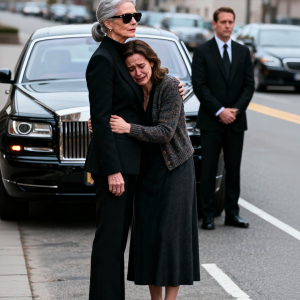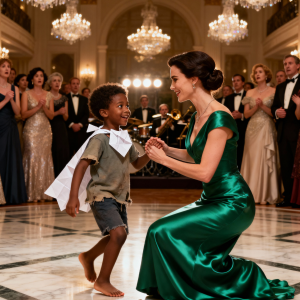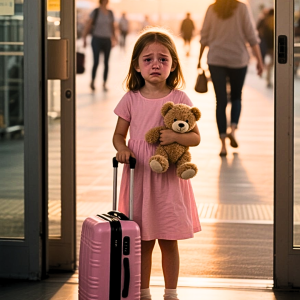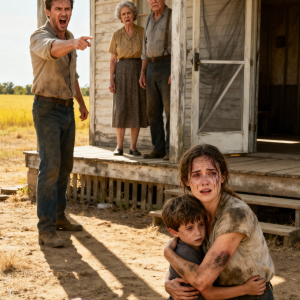
The rain poured down as I stood on the stone steps of the Halloway estate, clutching my newborn daughter to my chest. My arms trembled, my legs shook—but it was my heart, shattered and humiliated, that nearly brought me to my knees.
Behind me, the heavy mahogany doors slammed shut.
Just minutes earlier, Nathaniel—my husband—had stood silently beside his cold parents as they turned their backs on me.
“You’ve disgraced our name,” his mother whispered. “That child was never part of the plan.”
Nathaniel couldn’t meet my eyes. “It’s over, Emily. We’ll send your things later. Just… go.”
I couldn’t speak. My throat burned as I pulled my coat tighter around my baby. “It’s okay, Lily,” I whispered. “We’ll be fine.”
No umbrella. No purse. No home. They didn’t even call a cab. I knew they were watching as I walked into the storm.
The weeks that followed were a blur of shelters and sleepless nights. I sold my jewelry, my designer coat—everything but my wedding ring.
To survive, I played my childhood violin on subway platforms, every coin feeding Lily. I never begged. Not once.
Eventually, I found a cramped studio above a grocery store in Queens. The landlady, Mrs. Bennett, a retired nurse, saw something in me—desperation, maybe strength—and offered me cheaper rent if I helped in the shop.
By day, I worked the register. At night, I painted with thrift-store brushes while Lily slept in a laundry basket. It wasn’t much, but it was ours. Every smile from her reminded me what I was fighting for.
Three years passed.

One Saturday at a Brooklyn market, I set up a tiny stall. I expected nothing—just hoped someone would pause long enough to look.
That someone was Madeline Cole, a Soho gallery curator. She stopped in front of a painting of a mother holding her child in the rain.
“Are these yours?” she asked.
I nodded.
“They’re extraordinary. So raw.”
She bought three on the spot and invited me to exhibit next month.
I nearly said no—no babysitter, no clothes—but Mrs. Bennett insisted, lending me a dress and watching Lily herself. That night changed everything.
My work sold out. Commissions, interviews, magazine features followed. My story spread: abandoned wife, single mother, survivor.
I didn’t gloat. I didn’t seek revenge. But I never forgot.
Five years later, the Halloway Cultural Foundation invited me to collaborate. They didn’t know who I was. Leadership had shifted, and they needed fresh faces.
I entered the boardroom with Lily—now seven—beside me. Nathaniel was already seated. He froze when he saw me.
“Emily?” he whispered.
“Ms. Emily Carter,” the assistant corrected. “Our guest artist.”
I placed my portfolio on the table. “This exhibition is called Resilient. It’s a journey through betrayal, motherhood, and rebirth. Every dollar raised will support single mothers and children in crisis.”
The room fell silent. His mother, frail in a wheelchair, looked stunned. Nathaniel’s lips parted, but I cut him off. “You had a choice. And you closed the door.”
When Resilient opened in Tribeca, its centerpiece—The Door—depicted a woman holding a child at the gates of a mansion, eyes blazing with pain and determination. Critics hailed it a triumph.
Nathaniel came. He looked older, worn. “I never meant to hurt you,” he said.
“I believe you,” I answered. “But you let it happen.”
“Is there anything I can do now?”
“Not for me,” I said softly. “Maybe one day Lily will decide for herself.”
Years later, I opened The Resilient Haven, a nonprofit offering shelter, childcare, and art therapy for single mothers. Not for revenge—but so no woman holding her baby in the rain would feel as alone as I once did.
One evening, Lily—now twelve—played piano as other children laughed around her. I stood by the window, watching the sunset, and whispered with a smile:
“They didn’t break me. They gave me space to rise.”




